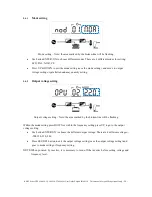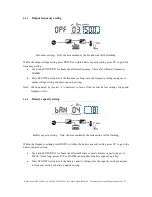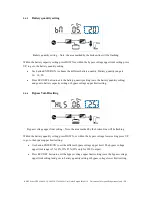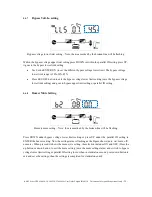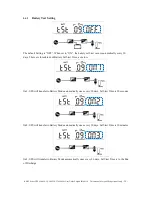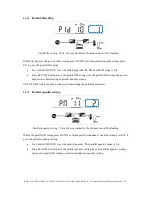
KE RT Series UPS 6-10kVA UL 208-220-230-240Vac User Guide English 20180130 This manual is for qualified personnel only
- 16 -
4
Installation
4.1
Inspecting the UPS
If any of the equipment received has been damaged during shipment, keep the shipping cartons and
packing materials in case a return is required and file a claim for shipping damage. If you discover
damage after acceptance, file a claim for concealed damage.
To file a claim for shipping damage or concealed damage: 1) File with the carrier within 15 days of
receipt of the equipment; 2) Send a copy of the damage claim within 15 days to your service
representative.
4.2
Unpacking the Cabinet
CAUTION
•
Unpacking the cabinet in a low-temperature environment may cause condensation to
occur in and on the cabinet. Do not install the cabinet until the inside and outside of
the cabinet are absolutely dry (hazard of electric shock).
•
The cabinet is heavy. Be careful unpacking and moving the cabinet.
To unpack the cabinet and accessories:
1.
Open the outer carton and remove the accessories packaged with the cabinet.
2.
Carefully lift the cabinet out of the outer carton.
3.
Discard or recycle the packaging in a responsible manner.
Place the cabinet in a protected area that has adequate airflow and is free of humidity,
flammable gas, and corrosion.
4.3
Installation notes
Place the UPS in a clean, stable environment, avoid the vibration, dust, humidity, flammable gas and
liquid, corrosive objects. To avoid from high room temperature, a system of room extractor fans is
recommended to be installed. Optional air filters are available if the UPS operates in a dusty
environment.
The environment temperature around the UPS should keep in a range of 0
℃
~
40
℃
. If the environment
temperature exceeds 40
℃
, the rated load capacity should be reduced by 12
%
per 5
℃
. The max
temperature must not be higher than 50
℃
.
If the UPS is dismantled under low temperature, it might be in a condensing condition. The UPS can't
be installed unless the internal and external of the equipment is fully dry. Otherwise, there will be in
danger of electric shock.
Batteries should be mounted in an environment where the temperature is within the required specs.
Temperature is a major factor in determining battery life and capacity. In a normal installation, the
battery temperature is maintained between 15°C and 25°C. Keep batteries away from heat sources or
main air ventilation area, etc.
Should the equipment not be installed immediately it must be stored so as to protect it against excessive
humidity and or heat sources.

















